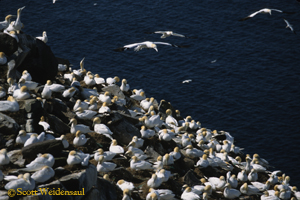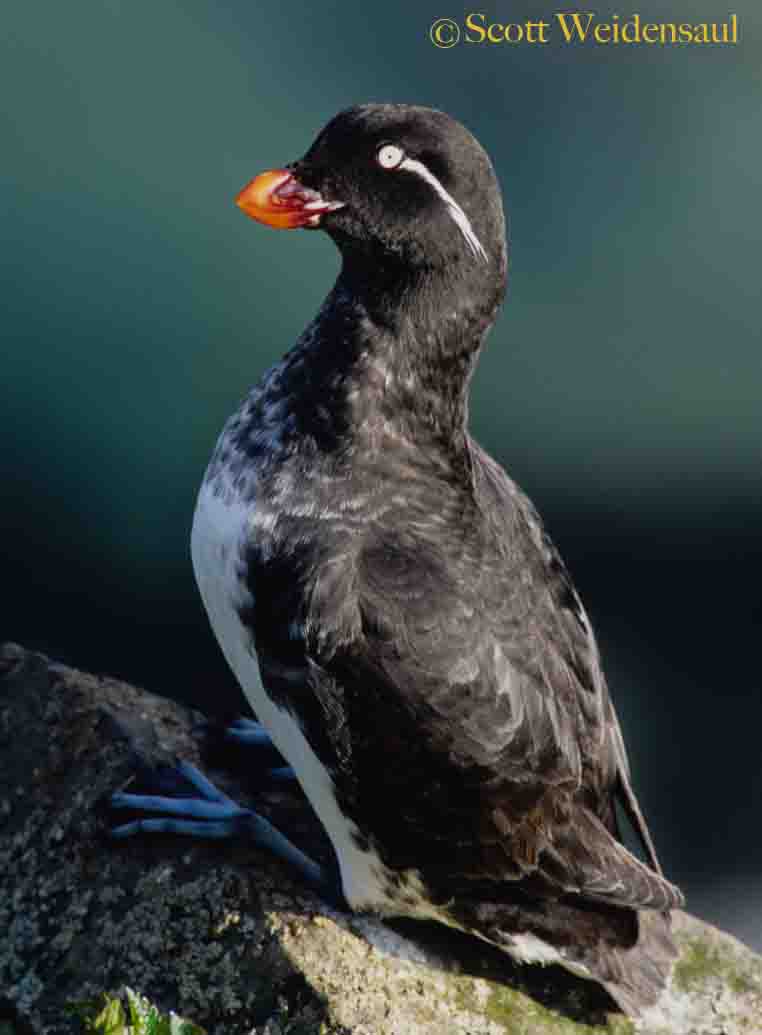Excerpt from Return to Wild America
Chapter 1
The mind is so easily tricked. One moment I was balanced over an abyss, waves crashing almost three hundred feet below me, the rim of the cliff a hundred feet above my head; my fingers were locked and white on the safety rope as I tried not to shift even fractionally from the narrow ledge of loose rock and dirt on which I had paused. Vertiginous space yawned below. I haven't an especially good head for heights, and this seemed, very insistently, to have been a bad idea.
 Northern gannets crowd the breeding ledges at Cape St. Mary's, Newfoundland (©Scott Weidensaul)Then cold fog enveloped me, the kind of thick, cotton-batting mist that's common to summer in the North Atlantic, and which has a solidity all its own. No longer able to see the long, lurching drop below me, I unconsciously relaxed; I took slower, deeper breaths, and my fingers eased up a bit on the rope. I realized that Tony, the fellow who was leading me down this wind-swept cliff on Newfoundland's Cape St. Mary's, was already vanishing into the white, and I resumed my undignified, butt-scraping descent behind him.
Northern gannets crowd the breeding ledges at Cape St. Mary's, Newfoundland (©Scott Weidensaul)Then cold fog enveloped me, the kind of thick, cotton-batting mist that's common to summer in the North Atlantic, and which has a solidity all its own. No longer able to see the long, lurching drop below me, I unconsciously relaxed; I took slower, deeper breaths, and my fingers eased up a bit on the rope. I realized that Tony, the fellow who was leading me down this wind-swept cliff on Newfoundland's Cape St. Mary's, was already vanishing into the white, and I resumed my undignified, butt-scraping descent behind him.
Tony stopped some yards further, down an even more precipitous slope, and with a final rain of small pebbles, I eased in beside him on a ridiculously thin finger of dirt and tufted grass. My glasses were clouded with moisture, and with one hand I dug out a handkerchief and cleaned them. That's when I noticed six murres perching on the edge of the dropoff, barely ten feet away - slim seabirds, black and white in a tuxedoed, vaguely penguinish way, sitting stiffly erect like bowling pins. Their beaks were thin and pointed, with a bit of an upward tilt. They cocked their heads, shifting from foot to foot and looking, from each other to us and back again, with what seemed to be incredulity: Humans? Here?
So captivated was I by the sight, that it took me a moment to realize that the fog had swept away. The chasm gaped below me again, but this time, it scarcely registered.
Birds. There were birds everywhere - a vast city of them, close enough almost to touch.
As though the fog had deadened all my senses, suddenly I was overwhelmed by renewed sight, sound and smell. On three sides, the cliff fell off vertically to the sea, where heavy green waves smashed to foam on the black rock. To our right, across a deep crevasse in which the breakers boomed and sucked, we faced a sheer wall just thirty feet away, and stared right into the faces of hundreds of nesting birds - murres jammed shoulder to shoulder, razorbills clinging to any purchase they could find, and the delicate little gulls called kittiwakes with their nests of piled seaweed. Gannets, huge and white, with rapier bills and tapered wings, wheeled above and below us, sailing through wraiths of mist snaking along the twisting breeze. The air reeked with the fish-guts smell of guano, and reverberated with noise - a wall of cries and screams. The moaning aaaaarrr-aaaarrrr of the murres, the shrill kitti-weeeeikk, kitti-weeeeikk of the gulls, the rattling barks of the gannets; the croak of an egg-stealing raven, whose sudden appearance panicked the colony into even greater crescendos.
In a lifetime of messing around with birds, the next half-hour, clinging to the side of Cape St. Mary's, ranks among the finest moments. It wasn't just proximity - this was an astonishing degree of intimacy with species that have always been little more than blurs in a spotting scope. I could see the individual white feathers that ringed the eye of a bridled murre, the sheen of iridescent green and blue on the scales of a slender fish it held clamped in its beak, the flecking of tiny mist droplets collecting on the brown-black feathers of its throat. Looking closely, I realized I could see my own reflection in its dark eyes.
This was the first time I had been to Cape St. Mary's, but in a vivid sense, it felt like a homecoming. In the spring of 1953, field guide author and birding guru Roger Tory Peterson set out with his friend, the noted British naturalist James Fisher, on what became a legendary journey - a 30,000-mile, 100-day marathon around the margins of North America, from the North Atlantic, down the Appalachians to the Florida Everglades, around the Gulf and coastal Texas and deep into Mexico, then up through the desert Southwest, along the Pacific coast into the Northwest, out into the tundra wilderness of western Alaska, and finally to the cold and remote Pribilof Islands in the Bering Sea. Two years later, in the fall of 1955, they published Wild America, a bestselling account of their travels which today remains a beloved classic.
Their journey began here, in Newfoundland, among the gannets and murres of Cape St. Mary's, one of the loneliest outposts of the continent's easternmost rim - a place of tundra barrens and twisted spruces, where herds of caribou graze on headlands below which whales breach and roll, and where seabirds by the tens of thousands crowd the rocky cliffs. For me, as for many naturalists who read that book over the past half-century, Cape St. Mary's has thus always had an almost electric pull, and the patina of great adventure.
 Parakeet auklet, Pribilof Islands, AK (©Scott Weidensaul)I first read Wild America as a kid, with a kid's understanding, and with a kid's jealousy and longing. I saw it as an almost endless holiday adventure, two buddies chasing birds and exploring distant, empty places - the deep swamps of the Florida panhandle where ivory-billed woodpeckers still lived; native villages in Alaska where Eskimos paddled skin boats and lived in sod-covered shelters; cloud forests in Mexico full of colorful birds I'd never heard of, whose names dripped exoticism: Motmot. Potoo. Euphonia.
Parakeet auklet, Pribilof Islands, AK (©Scott Weidensaul)I first read Wild America as a kid, with a kid's understanding, and with a kid's jealousy and longing. I saw it as an almost endless holiday adventure, two buddies chasing birds and exploring distant, empty places - the deep swamps of the Florida panhandle where ivory-billed woodpeckers still lived; native villages in Alaska where Eskimos paddled skin boats and lived in sod-covered shelters; cloud forests in Mexico full of colorful birds I'd never heard of, whose names dripped exoticism: Motmot. Potoo. Euphonia.
I came back to the book as a young adult who had begun his own travels, and with a fresh perspective. I was struck this time by the sheer magnitude of the task Peterson and Fisher set for themselves - the enormity of the distance they covered in just three and a half months, almost all of it in a big Ford station wagon that ran out of gas and blew tires in singularly inconvenient places. In spite of which, they still managed to average three hundred miles a day while setting a new record for the most species of birds seen in a single year, shooting miles of motion picture footage and hundreds of still photographs, and maintaining voluminous field notes on the rich diversity of plant and animal life they encountered. And through it all, these two close but relatively new friends (who had met just three years earlier) admitted to but a single argument in all those miles.
Now, when I read Wild America, it is with those past layers of excitement and admiration, but with something else keener and still more evocative - the realization that Fisher and Peterson saw a continent and a culture at a turning point. For a century before their trip, America's nascent conservation movement had been taking shape - sparked by disgust over the wholesale slaughter of wildlife, the pillaging of forests and the waste of natural resources. It had, in its early days, been driven by moneyed and well-educated society, but in the years following World War II, it began to emerge as a national force, drawing much of its strength from ordinary people who found enjoyment in amateur nature study.
